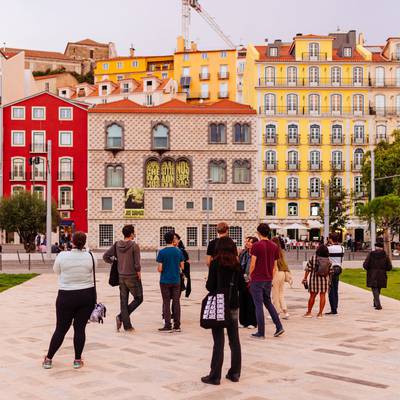
Where in Lisbon should I stay?
Lisbon's accommodation scene has exploded recently, so there is no shortage of places to stay, from historic buildings and palaces to excellent independent hostels. There are real bargains to be had in the off-season, but the city can get very busy from June to September. Prices are at their highest during the summer and you'll need to book ahead to avoid disappointment.
Chiado is probably the best area of Lisbon to stay in. You can walk to shops and sights in Chiado, Principe Real and Baixa and the restaurants and bars in Bairro Alto and Cais do Sodré. Served by the blue and green metro lines, a myriad of buses and tram 28, it’s about as convenient a location as they come. As well as a hotchpotch of big name stores and historical independent shops that have withstood decades of change, there are other things to see here, including:
- Largo do Chiado with the iconic Café A Brasileira and the statue of beloved poet, Fernando Pessoa
- The National Museum of Contemporary Art and several independent art galleries
- Largo de Camões, named after Portugal’s 16th century literary hero and a popular meeting spot
- Largo do Carmo, Convento do Carmo and the Archaeological Museum
- São Roque Church
- Filigree Museum
Some of the nice hotels to stay in the area include Lisbon Pessoa Hotel, Lisboa Carmo Hotel, Casa Balthazar, Teatro Boutique B&B. You can also rent an apartment or a room.
Baixa is another center location is stay in Lisbon. You’ll often see Baixa and Chiado grouped together on hotel booking platforms – these neighbourhoods are close enough to share a metro station, after all. The main difference is that Baixa, which means ‘low’, is just that; a flat grid of streets at the base of Lisbon’s city centre. The straight streets, named for the trade that each street was originally designated for, were designed by the Marquês do Pombal, the man responsible for rebuilding Lisbon after it was flattened by the 1755 earthquake.
The area has seen something of a revival in recent years with a crop of new hotels, shops, restaurants and museums and a revamped royal square next to the river. It can feel rather touristy and there’s a fair amount of traffic noise, so try to get a room facing away from busy streets or with good soundproofing (or pack earplugs!). On the plus side, it’s extremely convenient for walking around the centre and getting transport further afield.
Best accomodation options in the area include Internacional Design Hotel, Hotel da Baixa, Lisboa Prata Boutique Hotel, Lisbon Art Stay Apartments Baixa, Casas da Baixa - Jules & Madeleine, or this cute apartment.
If you walk up Rua da Misericordia from Chiado or head west up the hill from Avenida da Liberdade, you will find yourself in Principe Real, one of Lisbon’s trendiest and LGBTQ-friendliest neighbourhoods. Not only does it boast fabulous urban designer and concept shops and small attractive parks, it is also packed with restaurants and cafés.
It’s also on the doorstep of Bairro Alto, one of Lisbon’s most famous nightlife spots, but not so close that you’ll have revellers under your bedroom window until the wee hours. For all of these reasons, it’s one of the best places to stay in Lisbon if you want to balance day and nighttime activities with ease.
Principe Real is about 7 minutes walk from two metro stations – Rato on the yellow line and Baixa/Chiado on the blue and green lines. Buses run through the centre to connect you with Cais do Sodre and other parts of the city if you want to save your legs.
If you choose this area, try staying in Memmo Príncipe Real, Casa do Principe, 1869 Principe Real, Casa do Jasmim by Shiadu, Flores Guest House.
Another area is Avenida da Liberdade and Marquês do Pombal. The wide leafy avenue that runs through Lisbon city centre and connects the Baixa with Parque Eduardo VII, is lined with classy hotels and internationally-renowned designer stores. Many of the 5-star hotels in Lisbon city centre are in this area and they are mostly unique, historical and/or boutique.
The central strip of cobbled park offers patches of greenery and a few kiosk bars that can be quite lively in the early evening thanks to busking bands.
Once you get to the top of Avenida da Liberdade and past the statue of the Marquês do Pombal, you’re in a more business-oriented district with big banks and companies and busy main roads. Off these arterial roads there are smaller residential streets with all the amenities you’d expect to find, such as supermarkets and cafés. Hotels around the area tend to be the larger chain hotels.
Transport connections are easy, especially from Marquês do Pombal, which is about a 30-minute walk or 5-minute Metro ride from the Baixa district.
Best acommodation options in this area include Inspira Santa Marta Hotel & Spa, Heritage Avenida Liberdade, Valverde Hotel.
Bairro Alto is one of Lisbon’s liveliest districts for nightlife. During the day, it looks pretty workaday but at night, ground floor doors are thrown open to reveal numerous bars and restaurants although most people hang out in the streets. There are some quirky shops around and there’s some decent street art (and a lot of ugly graffiti).
If you’re young and want to party all night, you might want to stay in the thick of it but pick wisely and read reviews carefully. The neighbourhood spreads up a hill and although there are buses to nearby Principe Real, you’ll either have to walk into the labyrinth of narrow streets or take a taxi straight to your chosen venue.
For accomodation, try these hotels: Casa das Janelas com Vista, Palácio das Especiarias, Verride Palácio Santa Catarina.
Alfama, Lisbon’s oldest district spreads down the hill from St. George’s castle and encompasses the 12th century cathedral. Alfama’s narrow cobbled streets and tightly packed houses make it feel like a village within the city and there is still a close-knit community living here despite the ever-increasing volume of tourists.
Don’t be surprised to see remnants of street decorations or see people barbecuing sardines in the street, especially in June when there’s basically a month-long street party going on.
While atmospheric and definitely a place to get lost in during the day, you might find Alfama more frustrating when the taxi driver can’t find your accommodation or you’re trying to make your way back at night.
Tram 28 trundles through this neighbourhood but otherwise, it’s not the most convenient of neighbourhoods in terms of public transport. There are some free public elevators that make it easier to cope with the hill during working hours. Other than that, you’ll have to walk or take a cab.
Best accomodation in Alfama includes Memmo Alfama, Hotel Convento do Salvador, Alfama - Lisbon Lounge Suites, Hotel Riverside Alfama. There are also lots of AirBnB apartments in Alfama, and neighbouring Mouraria, but bear in mind that the buildings are old and the standard of renovation may be questionable in some cases so read reviews very carefully before choosing one.
There are, of course, other places to stay in Lisbon that are away from the main hustle and bustle yet also allow you to do a great deal of sightseeing and exploring on foot, like Madragoa/Santos or Estrela/Lapa.

Where to buy alcohol in Portugal and how much does it cost?

What alcoholic drinks to try while in Portugal?

What are the restrictions regarding alcohol consumption?

What soft drinks are available?

How to get to Portugal?

 What are the accomodation options in Portugal?
What are the accomodation options in Portugal?